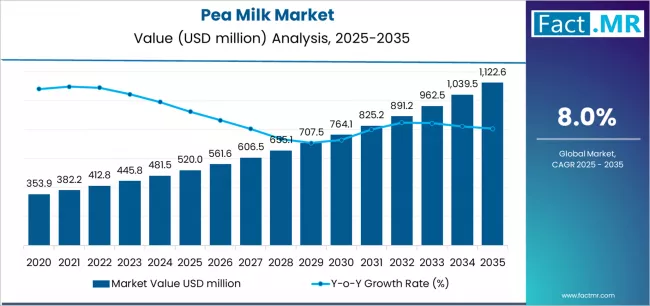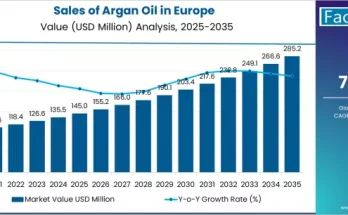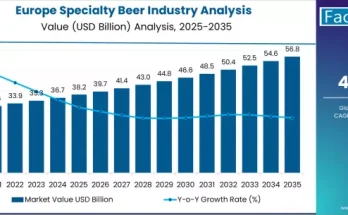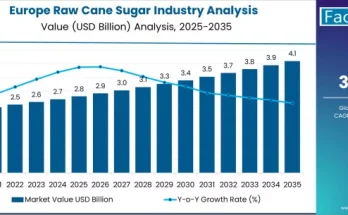The global pea milk market is witnessing rapid expansion as consumers increasingly shift toward sustainable, plant-based, and allergen-free dairy alternatives. According to a recent report by Fact.MR, the market is valued at USD 520 million in 2025 and is projected to reach USD 1,122.6 million by 2035, registering an absolute growth of USD 600 million over the forecast period. This reflects a compound annual growth rate (CAGR) of 8% between 2025 and 2035.
Pea milk—derived from yellow split peas—is emerging as a front-runner in the alternative milk category due to its superior nutritional profile, neutral taste, and low environmental footprint compared to dairy and other plant-based milk sources.
Strategic Market Drivers
- Rising Demand for Plant-Based and Allergen-Free Alternatives
Growing consumer awareness of lactose intolerance, dairy allergies, and vegan lifestyles is accelerating the global adoption of plant-based milk. Pea milk offers an edge with its high protein content, rich texture, and absence of common allergens like soy or nuts. Its clean-label positioning appeals to health-conscious consumers and those prioritizing ethical food production.
- Sustainability and Environmental Impact
Compared to almond and dairy milk, pea milk requires significantly less water, land, and energy to produce. As climate-conscious consumers and companies push for greener products, the environmental sustainability of pea protein positions it as a core ingredient in the future of food.
Major beverage manufacturers are reformulating their portfolios with low-carbon alternatives, with pea milk becoming a key player in this transition.
- Innovation in Flavor and Nutrition
Continuous R&D is expanding pea milk’s appeal through fortification with calcium, vitamin D, and omega-3 fatty acids, improving both taste and nutrition. Enhanced processing technologies are also reducing the earthy flavor traditionally associated with pea-based drinks, allowing for better consumer acceptance in mainstream markets.
- Expansion in Foodservice and Retail Channels
From coffee chains to online marketplaces, pea milk is gaining strong visibility. Partnerships between retail brands and quick-service restaurants have boosted consumer trials, while private-label launches are expanding accessibility across supermarkets and e-commerce platforms.
Browse Full Report: https://www.factmr.com/report/5346/pea-milk-market
Regional Growth Highlights
North America: The Epicenter of Plant-Based Innovation
North America continues to dominate the global pea milk market, led by strong consumer adoption in the United States and Canada. Demand is bolstered by major food tech startups and partnerships with café chains integrating pea milk as a dairy alternative. The region’s leadership in vegan trends and functional food innovation drives sustained market growth.
Europe: Regulation and Lifestyle Convergence
Europe’s strict sustainability regulations and rapidly expanding vegan population make it a fertile ground for pea milk expansion. Countries such as the U.K., Germany, and the Netherlands are leading consumption trends, driven by high awareness of animal welfare and carbon reduction.
Asia-Pacific: Emerging Hub for Plant Protein Development
Asia-Pacific is witnessing a surge in plant-based milk production as regional food processors invest in localized pea cultivation and functional beverage innovation. Growing urban populations, lactose intolerance prevalence, and a shift toward Western-style diets contribute to accelerating adoption in China, Japan, and Australia.
Emerging Markets: Latin America and the Middle East
New growth corridors are opening in Latin America and the Middle East, driven by increasing health awareness, international brand penetration, and rising disposable incomes. These regions present untapped potential for manufacturers introducing affordable and fortified plant-based beverages.
Market Segmentation Insights
By Flavor Type:
• Original
• Unsweetened
• Vanilla
• Chocolate
By Distribution Channel:
• Supermarkets & Hypermarkets
• Convenience Stores
• Online Retail
• Cafés and Foodservice Outlets
By End User:
• Retail Consumers
• Foodservice Industry
• Food and Beverage Manufacturers
Challenges and Market Considerations
Despite strong growth prospects, the pea milk market faces notable challenges, including:
• High Production Costs – Protein isolation and flavor neutralization remain capital-intensive.
• Taste and Texture Optimization – Ongoing R&D is vital to match consumer expectations of dairy milk.
• Competitive Pressure – Soy, almond, and oat milk continue to dominate shelf space in mature markets.
• Supply Chain Complexity – Dependence on yellow pea production and processing infrastructure affects scalability.
Competitive Landscape
The global pea milk market is highly consolidated, with key players focusing on sustainable sourcing, flavor innovation, and product diversification. Leading companies are expanding distribution networks, investing in protein extraction technology, and collaborating with foodservice brands to enhance consumer reach.
Key Players in the Pea Milk Market:
• Ripple Foods
• Danone Alpro
• Nestlé
• Califia Farms
• Dream
• Sproud
• Vitasoy
• Pacific Foods
• Elmhurst
• Good Karma
Future Outlook: Toward a Sustainable, Protein-Rich Future
The next decade will redefine the global beverage industry as consumers prioritize nutrition, sustainability, and ethical consumption. Pea milk stands at the intersection of these megatrends—delivering protein-rich, allergen-free, and eco-friendly solutions for modern lifestyles.
With rapid advancements in food technology, ingredient sourcing, and flavor innovation, the pea milk market is poised to become a mainstream segment of the global dairy alternatives industry. Companies that leverage R&D, transparent labeling, and sustainable supply chains will be best positioned to capture growth in this dynamic and transformative market.



